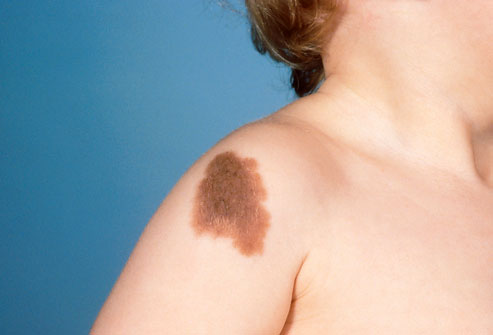Birthmark - types, symptoms, removal and treatment

Birthmark is a discoloration on a newborn’s SKIN present at, or that emerges within a few weeks of, birth. Birthmarks are either vascular (composed of BLOOD vessels and red in color) or pigment (patches of skin that differ in color from the surrounding skin). Though some birthmarks, especially large ones, may be permanent, many fade to become faint or unnoticeable by about age 10 years. Most birthmarks do not present any health problems, though large or obvious birthmarks often arouse concern for cosmetic reasons. Occasionally vascular birthmarks arise in sites where they can interfere with vision (when near the EYE or on the eyelid), BREATHING (when near the entrance to the NOSE), or feeding (when on the lips).
Symptoms of Birthmark and Diagnostic Path
Most birthmarks are present at, or appear shortly following, birth. Some vascular birthmarks may not appear for several months after birth. When this is the case, the birthmark appears suddenly and grows rapidly, then remains at a steady size. Many vascular birthmarks then disappear as the child grows older. The doctor can identify most birthmarks based on physical appearance. The doctor may choose to conduct MAGNETIC RESONANCE IMAGING (MRI) or COMPUTED TOMOGRAPHY (CT) SCAN when there is a cavernous hemangioma because this kind of blood vessel tumor (noncancerous) can occur within internal organs such as the LIVER or BRAIN and creates a risk for HEMORRHAGE (uncontrolled bleeding), or the doctor may perform a biopsy (take a tissue sample to examine under a microscope) of lesions of questionable composition. Multiple café au lait spots (six or more) can suggest NEUROFIBROMATOSIS, a genetic disorder, and require further evaluation. Congenital dermal melanocytosis (Mongolian spot) often has the appearance of a large bruise (ECCHYMOSIS), sometimes raising concerns about CHILD ABUSE among those who are not familiar with this birthmark. A health-care provider can quickly distinguish the mark and determine that it is not a bruise.
Any change in the size, color, or characteristics of a birthmark, especially a NEVUS (mole), requires prompt medical evaluation to check for malignant melanoma or other SKIN CANCER.
Birthmark Treatment Options, Removal and Outlook
Most birthmarks fade by ADOLESCENCE, making treatment unnecessary. The doctor may choose to surgically remove nevi (moles) that are large or in locations where they are subject to irritation from clothing or movement, to prevent them from evolving to SKIN CANCER. Port wine stains (flat hemangiomas) are often emotionally distressing when they occur on the face. The dermatologist may use laser therapy to shrink and seal off the blood vessels causing the port wine stain, diminishing its prominence. Cover-up cosmetics are also an option. Children are particularly sensitive about having obvious birthmarks and may need emotional support. Birthmarks are very common, with some experts estimating that about a third of infants are born with them.
Types of Birthmarks
| Birthmarks | |||
|---|---|---|---|
| Clinical Name | Type | Common Names | Characteristics |
| capillary hemangioma | vascular | strawberry hemangioma | red discolorations that resemble strawberries most common on the face, back, chest, and back of the neck may be nonexistent at birth, then within a few weeks appear and rapidly grow generally fade by age 9 |
| cavernous hemangioma | vascular | none | purple or reddish blue cluster of blood vessels beneath, rather than on the surface of, the SKIN may be quite large, with a spongy consistency may exist within internal organs such as the LIVER, BRAIN, and BONE present at birth or appears within a few days of birth susceptible to possibly profuse bleeding with trauma may require surgical removal |
| congenital dermal melanocytosis | pigment | Mongolian spot, Mongolian blue spot |
common among infants with dark skin dusky blue coloration, can cover a large area most often appears on the lower back or buttocks present at birth or appears within a few days of birth generally fades by age 12 |
| congenital NEVUS; giant congenital nevus | pigment | mole | cluster of pigmented cells may be flat or raised may have HAIR growing from it (called hairy nevus) increased risk for malignant melanoma when > 20 centimeters (giant congenital nevus) |
| nevus flammeus | vascular | stork bite, salmon patch | small, pink, irregular discolorations of the skin most common on the face and back of the neck may be nonexistent at birth, then within a few weeks appear and rapidly grow generally fade by age 4 |
| nevus flammeus | vascular | port wine stain | most often appears on the face persists into adulthood |
| hyperpigmented MACULE | pigment | café au lait spot | coloration similar to coffee with milk faint appearance at birth, becomes more prominent by age 3 More than five or six spots may suggest neurofibromatosis |
Birthmark Risk Factors and Preventive Measures
Birthmarks appear to be random and common, with as many as a third of newborns having at least one. Because researchers do not know what causes them to occur, there are no known measures for preventing them. Any changes in a birthmark that has been stable in size and appearance warrant a doctor’s evaluation to determine whether the changes signal skin CANCER. Early detection and treatment are especially crucial for malignant melanoma, in which a NEVUS becomes cancerous, as this cancer can be aggressive and lethal when untreated. Birthmarks themselves do not present any risk to overall health.
See also ANGIOMA; GENETIC DISORDERS; LESION.